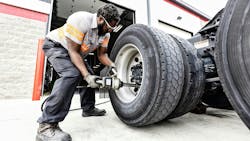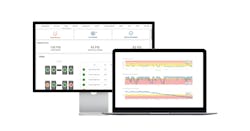This is Part Two of a Two-Part story. To read Part One, click here.
Managing tire data isn't only helpful for fleet managers looking to improve operations. This data can be an invaluable tool for technicians, too, especially from tire pressure management systems (TPMS) that can help direct maintenance teams to tires that need service.
This is especially helpful if a tire is suffering from a long, slow leak that an automatic tire inflation system (ATIS) might help keep on the road, but will need patching or replacing if a fleet wants to maintain its uptime and efficiency. But there are other technologies to help give technicians even more insight into their fleets' tires, with sensors for everything ranging from tire pressure to temperature.
Data that tips off technicians
As an example of how various tire technologies work together to keep technicians informed, consider if a TPMS finds that the ATIS control box is kicking into high gear when it shouldn't be. If the auto-inflate system is kicking on and staying on, the technician knows that the tire incurred some damage that requires immediate attention.
“The bottom line is that TPMS data will point to those injuries and leaks, so the maintenance staff knows to take a closer look,” said Matt Wilson, general manager of the controls business unit, brake and wheel-end group at Hendrickson. That is why Hendrickson offers an integrated TPMS sensor option with all of its TireMaxx auto-inflate systems. That TPMS data can be monitored by any telematics device that can receive Bluetooth messages.
TPMS data can also alert maintenance teams to any issues with an auto-inflate system itself.
“Fleets using a comprehensive tire health monitoring solution will see underinflated tires that should have been inflated by a properly maintained automatic tire inflation system,” said Cliff Creech, SVP of engineering and operations at Phillips Connect, a provider of sensors, analytics platforms, and other IoT solutions. “This comprehensive approach allows fleets to dispatch technicians to address both the obvious tire issue and any underlying issues with the ATIS.”
Fleets have numerous TPMS options to choose from. As is the case with autoinflate systems, some are more sophisticated than others.
“The most robust help give an indication of treadwear, along with inflation, temperature, and load,” said Robert Chernow, director of national tire maintenance at Ryder. “Having that digital fingerprint of each tire is the next best thing to physically taking a tire off a vehicle to inspect it.”
For example, underinflation tends to cause accelerated wear on the inside and outside edges of a tire, whereas overinflation causes faster wear in the center. If TPMS data tells a technician that a certain tire is chronically under- or overinflated, that technician can check for signs of accelerated wear in a more predictive fashion.
Tire data is integral to Goodyear’s new Tires-as-a-Service solution. But there’s more to tire health than inflation.
“Total cost of ownership goes beyond simply keeping tires from going flat while in operation,” explained Michelle Ross, head of sales and marketing for Goodyear TaaS. “The benefits of Tires-as-a-Service are a result of the complete management of tires, from monitoring tire health to scheduling and executing tire maintenance proactively.”
Goodyear’s Tires-as-a-Service offers 24/7 remote monitoring of tire pressure, temperature, and treadwear, with live tire monitoring data available on the Goodyear Mobility Cloud.
“Our solution uses technology powered by Goodyear SightLine, including a sensor on every tire, a telematics control unit (TCU), and ATIS inflators on drive and trailer positions,” Ross said, adding that the sensors are either valve-cap or tire-mounted.
The subscription-based program leverages the Halo Tire Inflator from Aperia Technologies, an externally mounted device on the wheel that captures a tire’s rotational energy and converts it to pressurized air, to help reduce emergency roadside events.
Treadwear is another area of focus.
“Using all of the data from our technology, we have developed proprietary algorithms to estimate treadwear,” Ross said. “Goodyear representatives use these insights to proactively schedule maintenance for the fleet, addressing potential issues before they worsen.”
New technology to aid technicians
After the data is collected by the sensors, fleets can leverage artificial intelligence and machine learning to proactively address tire issues.
Predictive analytics and machine learning are cornerstones of Aperia’s Halo Connect TPMS solution, which is on nearly 250,000 heavy- and medium-duty trucks.
“We’ve built alerting algorithms based on more than 100 billion miles of real-world experience to detect tire underinflation and leaks,” noted Ralph Dimenna, Aperia chief commercial officer.
Halo Connect combines pressure and temperature data with geolocation information from the telematics gateway. When used in conjunction with its Halo Tire Inflator, Halo Connect also collects information on the amount of air pumped into a tire, tire rotations, diagnostics on inflator performance, as well as advanced information from embedded accelerometers. Machine learning then assesses all of those variables to categorize tire issues by severity, allowing fleets to improve maintenance planning and resolve critical issues faster.
Read more: Aperia Halo Connect expands diagnostic and tire management capabilities
Recently, Aperia upgraded Halo Connect to offer a tire tread diagnostics suite and remote tire pressure adjustment capabilities. Using Aperia’s laser-based handheld 3D tread scanner, shops can also receive advanced tire service recommendations and maintenance insights, such as detecting irregular and excessive tire wear, mismatched tires, and alignment issues.
Dimenna said these advancements can improve a fleet’s fuel economy by 1% to 2%, and also reduce emergency roadside service calls by up to 90%. The overall tire budget also benefits by extending tire life by 15% to 20%. According to Aperia, these features can save $2,000 per truck annually.
“These new capabilities close the loop for active tire maintenance, transforming tire management for fleets,” Dimenna said. “These innovative features are simple to implement and act upon. Halo Connect i3 advanced tread diagnostics and remote adjustments deliver tremendous leverage for optimizing operations.”
Another scanning option is Anyline’s Commercial Tire Tread Scanner, which collects vital data including tire IDs, tread depth, sidewall condition, and tire size simply by opening the app and pointing at the tire. The software tool works on any camera-enabled smartphone or mobile device.
“Tire tread scanning is the fastest and easiest way to monitor the health of a tire,” said Lukas Kinigadner, CEO and co-founder of Anyline. “When fleet operators scan tire information accurately, they have better data on tire health, making it easier to pull a tire for replacement or retread at the optimal time. Fleet companies can optimize the use of each tire on their vehicles, which reduces costs, ensures vehicle uptime, and enables fleet owners to better schedule maintenance.”
Maintenance teams can also leverage TPMS data with other data such as mileage and GPS location to provide further predictive insights.
“A technician could identify treadwear patterns based on vehicle, load, where it’s driving, and how much it’s driving,” explained Kellie Taube, VP of global sales at Pressure Systems International (P.S.I.). “This combination of data could help with treadwear predictive analytics to better manage other tires in the same type of application.”
Tires and temperature
Temperature is another thing to pay attention to.
“Heat is a huge enemy of tire life,” Chernow said, adding that today’s leading tire brands rarely wear prematurely unless an upstream issue is causing it. In other words, chronic heat could signal premature wear, premature wear could signal an upstream issue, and the TPMS data could prompt a closer look on a more predictive basis.
“If a tire is wearing unevenly, it’s possible that the axle has shifted, or the pin that holds it in place is worn,” said Jake Schel, an editorial consultant with Mitchell 1, a provider of vehicle repair software and repair shop solutions, including TruckSeries repair information software for Classes 4-8 trucks. “Now you have four tires running slightly crooked, feathering as they go, and running hotter.”
As another example, let’s say a garbage truck is seeing consistently high temperatures at one of the wheel positions. Seeing as how often a garbage truck has to stop, it’s possible there is a worn brake pad. “That temperature data could be what prompts the technician to take a look before a rotor is ruined, too,” Taube said.
“Temperature often indicates whether a tire is operating at its optimal pressure,” Mitchell 1’s Schel noted. “A tire with low pressure will run hot. If some systems detect rising temperatures and increased load on a tire, they may increase the air pressure to maintain the best temperature range while traveling.”
Some of today’s more advanced systems also utilize wheel-speed sensors. “Faster wheel speeds can increase temperature, and the system compensates by adjusting tire pressure to prevent a blowout,” Schel explained.
That is why Hendrickson is planning to offer a more comprehensive sensing solution in mid-2025.
“Our Watchman solution will be able to monitor for tire pressure, as well as other wheel-end issues such as bearing health by monitoring things like wheel-end temperature,” Wilson said. Hendrickson plans to make the data available on the CAN bus, which would make it possible for any CAN-enabled device on the trailer to monitor the data, including most trailer telematics systems. Watchman will also include a mobile app for quick and easy monitoring.
P.S.I.’s newest wheel-end solution, Digital ThermALERT, provides real-time visibility into hub temperatures. Furthermore, it allows maintenance teams to set parameters as to when they’d like to be alerted about abnormalities. That’s an important aspect of data-driven maintenance. Too much data can become overwhelming. On the other hand, customized alerts and user-friendly dashboards help fleets recognize the important things that need to be dealt with.
“With our conventional ThermALERT, it would activate at a certain temperature with no warning,” Smith explained. “It would still help save the wheel end and trailer. But with Digital ThermALERT, by looking at the real-time data through our TireView LIVE portal, the fleet can identify where the good operating temperature range sits for that vehicle. The fleet can set an alert when the temperature rises above that ideal range, but is not yet up into that critical range. An immediate roadside service may not need to be scheduled, but the driver does need to know there’s an issue that needs to be looked at, potentially at their next stop.”
This type of wheel-end data can help catch signs of brake dragging above and beyond what a TPMS temperature reading might indicate. Bearings that were overtightened during a recent service could also cause a spike in wheel-end temperature. Additionally, bearings that are beginning to fail, lack of lubricant, and over-adjusted brakes can also cause excessively high hub temperatures.
“One of our fleet customers had a scenario where a vehicle left the shop and the maintenance manager got alerts on all four hubs at once,” P.S.I.’s Taube related. “Come to find out, the technician had over-adjusted the slack adjusters. Nobody would have ever known if not for that real-time wheel-end data that forced them to take a look.”
When you get down to it, an auto-inflate system, TPMS, and wheel-end sensors are really at their best when they work hand in hand. And when maintenance teams make use of the data these systems provide, they can avoid many tire-related issues altogether. That requires a mindset shift among many maintenance professionals, even when you’re just talking about TPMS.
About the Author

Gregg Wartgow
Gregg Wartgow is a freelancer who Fleet Maintenance has relied upon for many years, writing about virtually any trucking topic. He lives in Brodhead, Wisconsin.



